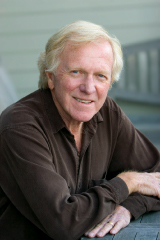Within a year, two decisions will be made affecting hundreds of thousands of Marin residents for years to come. They involve electrical power to our homes and businesses, and meeting our water needs in case of drought. Voters will not have a direct say on either matter. Instead, several dozen elected leaders will decide these issues. As objectively as possible, I want to clarify both concepts.
In 2002, the state Legislature allowed cities, counties and regions to decide what kind of power—fossil fuel, renewable, or a combination of both—they wished to use. In 2004, Marin, led by Supervisor Charles McGlashan, began pursuing “greener” energy—and Marin Clean Energy was born.
Marin’s electrical power, as supplied now by PG&E, a private utility company, comes from natural gas power plants, the Diablo Canyon nuclear power plant and dams in the High Sierra.
In addition, about 12 percent of PG&E’s power comes from solar arrays and wind farms. The state has mandated that PG&E increase that proportion to 20 percent by 2010, but many, including PG&E, acknowledge the challenge of reaching that target.
Marin Clean Energy maintains that a local public power entity can provide 25 to 50 or even 100 percent green power in the not-too-distant future. PG&E and local critics say that forecast is unrealistic, arguing also that power generation and allocation is a complex business requiring a network of suppliers and years of experience and expertise.
Regardless, in November 2008 the county (representing unincorporated communities) and eight of Marin’s 11 cities (Novato, Corte Madera and Larkspur excluded) created the Marin Energy Authority, a joint powers agency to compete with PG&E. MEA recently received acceptable bids from a dozen energy providers and hopes to sign off on a formal agreement later this year. (Cities in the MEA can still decide not to sign; the three cities not included, could join at a later date.) What happens next?
If your local government approves the power contract, you have three options: 1) “Opt out” and stay with PG&E. 2) Go “Light Green” and receive 25 to 50 percent renewable energy at a rate, according to MEA, equal to PG&E’s. 3) Go “Dark Green” and receive 100 percent green energy at a rate, according to MEA, 10 percent more than PG&E’s. Whatever your choice, power will still be delivered by, and billed by, PG&E.
In 2001, the Marin Municipal Water District, which serves southern and central Marin, proposed a water desalination plant. The motivation comes from Marin being 98 percent dependent on rainfall for water because the county has no aquifers or spring-fed lakes.
The water district has seven reservoirs that store nearly 80,000 acre-feet of water. In turn, the district’s requirements—including San Quentin State Prison, which is near the proposed desalination plant’s location—equate to more than 40,000 acre-feet a year. Do the math: back-to-back winters of less than half of normal rainfall (52 inches at Lake Lagunitas) puts Marin in dire economic and quality-of-life circumstances. (In 1977, the county had to beg money to rig a pipe over the Richmond–San Rafael Bridge to bring in water.)
Few deny the problem; the debate is over a solution. The desalination plant would generate 5 million gallons a day (about 11 acre-feet) and cost $110 million to build; it could be expanded to 10 million gallons for an additional $61 million. It would be at full power only in times of limited rainfall.
Those opposing desalination say it’s too costly; its power needs generate excessive greenhouse gases; and it creates brine that will damage the bay’s ecology. They also say rates, taxes, and development will increase with such a plant and that greater conservation is a better course. Regardless, the water district’s directors approved the plant in August. Yet a year of hearings and environmental approvals remain before construction starts.
Both issues—Marin Clean Energy and a desalination plant—are being decided by several dozen elected officials despite calls for a popular vote. These leaders need your input. Both Marin Clean Energy and the Marin Municipal Water District maintain active websites—and local council members are in the phone book.
Personally, I favor both concepts, but current economic uncertainties have me following the debate closely. That is my point of view. What’s yours?
E-mail [email protected].


